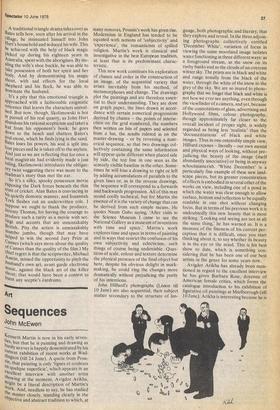Art
Sequences
John McEwen
41'euneth Martin is now in his early seventies, but that he is painting and drawing as uusily as ever is happily demonstrated by his crrent exhibition of recent works at Waduiugton (till 24 June). A quote from Pons sin, that painting is only `lignes et couleurs ea quelque superficie', which appears in an excellent interview with another artist Showing at the moment, Avigdor Arikha, might be a literal description of Martin's Work. And, needless to say, he has studied th,e. master closely, standing clearly in the Objective and abstract tradition to which, at
many removes, Poussin's work has given rise. Modernism in England has tended to be equated with notions of 'subjectivity' and 'experience', the romanticism of spilled religion. Martin's work is classical and investigative in the best European tradition, at least that is its predominant characteristic.
This new work continues his exploration of chance and order in the construction of an image, of the sequential variety that arises inevitably from his method, of metamorphoses and change. The drawings plot the paintings and are therefore essential to their understanding. They are done on graph paper, the lines drawn in accordance with certain numerical progressions derived by chance — the points of intersection on the grid numbered, the numbers then written on bits of papers and selected from a hat, the results rulered in on the master-drawing — or by reversing a numerical sequence, so that two drawings collectively containing the same information will appear quite different when placed side by side, the top line in one • seen as the scarcely visible baseline in the other. Sometimes he will bias a drawing to right or left by adding accumulations of parallels to the given lines or, as in the reverse drawings, the sequence will correspond to a forwards and backwards progression. All of this may sound coolly technical, but for Martin the essence of it is the variety of change that can be derived from such simple means. He quotes Naum Gabo saying, 'After visits to the Science Museum I came to see the National Gallery as a museum of inventions with time and space.' Martin's work explores time and space in terms of painting and in ways that restrict the confusion of his own subjectivity and eclecticism, such things of course being undeniable. Questions of scale, colour and texture determine the physical presence of the final object but here, despite his obvious delight in markmaking, he could ring the changes more dramatically without prejudicing the purity of his intentions.
John Hilliard's photographs (Lisson till 10 June) are also sequential, their subject matter secondary to the structure of Ian guage, both photographic and literary, that they explore and reveal. In the three adjoining photographs collectively entitled 'December White', variation of focus in viewing the same moorland image isolates water functioning in three different ways: as a foreground stream, as the snow on its rushy banks and as the clouds of an overcast winter sky. The prints are in black and white and range tonally from the black of the water, through the white of the snow to the grey of the sky. We are so inured to photography that we forget that black and white is not how we ever see anything, even through the viewfinder of a camera, and yet, because of the connotations of glass, advertising and Hollywood films, colour photography, though approximately far closer to the overall incident of proper sight, is widely regarded as being less 'realistic' than the 'documentations' of black and white images. Thus in one ostensibly simple view, Hilliard exposes — literally — our own mental and physical ways of looking, without prejudicing the beauty of the image (itself abundantly associative) or being in anyway schoolmasterish. 'White December' is a particularly fine example of these new landscape pieces, but its greater concentration of effects is embodied in several other of the works on view, including one of a pond in which the water was clear enough to allow surface, bottom and reflection to be equally readable in one shot without changing focus. But in terms of his previous work it is undoubtedly this new beauty that is most striking. 'Looking and seeing are not at all the same thing,' he has warned us. It is a measure of the fineness of his current perception that it is difficult, once you start thinking about it, to say whether its beauty is in the eye or the mind. This is his best show to date, which is something considering that he has been one of our best artists in the genre for some years now.
Avigdor Arikha has already been mentioned in regard to the excellent interview he has given Barbara Rose, doyenne of American female critics, which forms the catalogue introduction to his exhibition of figurative oil paintings at Marlborough (till 10 June). Arikha is interesting because he is an abstract artist who has worked through to figuration and is able to articulate his reasons for doing so very precisely. His paintings look better in reproduction than realoty and are not the equal of his conversation, but they have a certain warmth, particularly when the depict simple things like bread and apples with a degree of luscious, but never vulgar, modulation. His figures and landscapes and his watercolours are wuzzy in comparison.



































 Previous page
Previous page